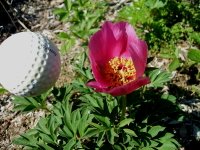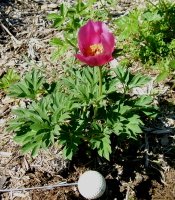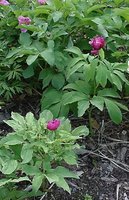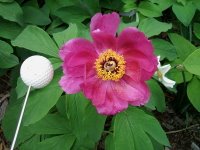Finally things warmed up here, outside, although remaining cloudy. Then 2 days of sun and it was suddenly almost hard to hear anything except peonies popping.
I had decided to try my darndest to prevent the bees from cross-pollinating the darker-flowered species into the lighter ones. This has meant clipping the buds of many plants while they are well-coloured but not quite open. But what to do with them all? Well, a couple of floating cut-flower projects have evolved. 6 buds of P mascula filled a large glass mixing bowl once all opened, but I'd have needed over a dozen of them. So some clean plastic planting trays sufficed, or will eventually, for the rest, holding about 40 buds each (now working on the third). In addition to mascula, there are a lot of P caucasica and P kesrouanensis, some P ruprechtiana (all 3 of those of the mascula clan and very similar), and a few early P veitchii and P officinalis.


So now the yellows and whites are free to be bee'd without muddying their colours, if not exactly keeping their gene pools clean (I'll do some hand-pollinating with a paintbrush to help that aspect). But wait, I also really need seed of P triternata, so there is the slight chance of some pink after all. Oh well. And then there's the bright red P tenuifolia in bloom in one location: that colour is welcome to mix with the yellows if it wants!
Blogger refuses to insert photos in the order I send them, and moving them around has crashed the blog more than once, so the following are not in my preferred order; but what the heck.

White form of P steveniana, flower and plant. That's about as open as the flowers of this species get.

 A very pale form of P mlokosewitschii, which started to open yesterday. There is a subtle blush of pink at the base of the petals. I call this the "Moonlight form". This plant is one year out of the pot, where it had 2 stems last year.
A very pale form of P mlokosewitschii, which started to open yesterday. There is a subtle blush of pink at the base of the petals. I call this the "Moonlight form". This plant is one year out of the pot, where it had 2 stems last year.P steveniana proper, a bit paler than mlokosewitschii and a bit darker than P tomentosa (which is done now). And a grouping of 3 plants.


























